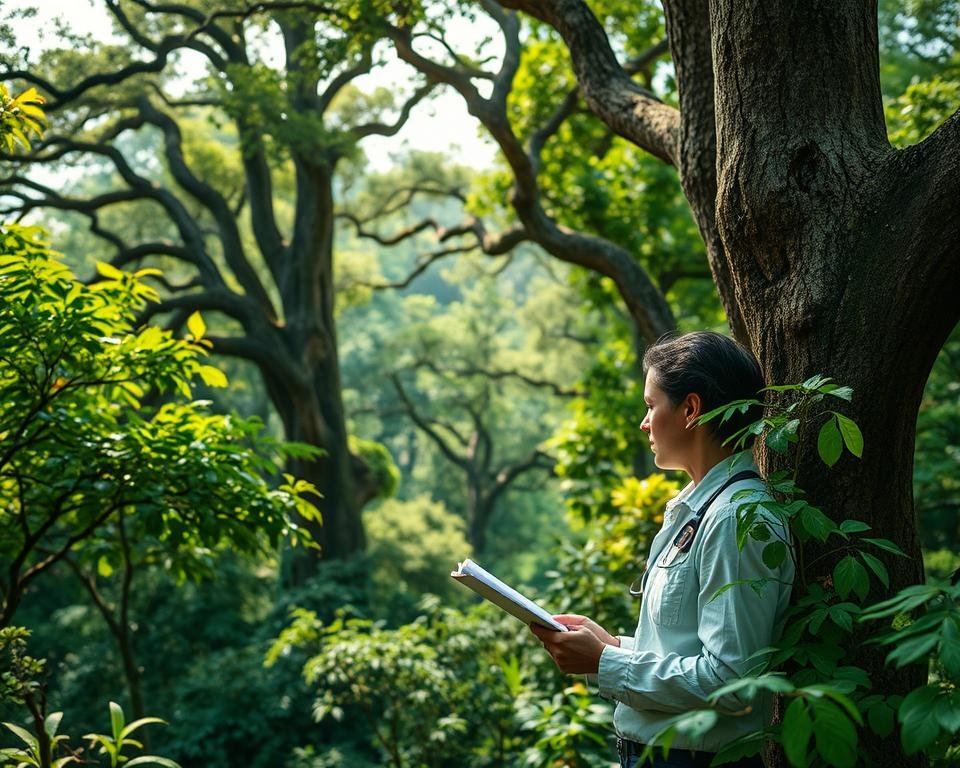Anúncios
I recently learned a fascinating fact. Forests with high genetic variation can better handle environmental changes. This made me think about how important it is to keep tree genetic diversity alive. Exploring this topic shows how vital it is for our ecosystems’ health.
Anúncios
Forests are more than just trees; they are complex ecosystems. Genetic diversity is key here. It helps forests deal with climate change, fight off diseases, and keep ecological balance. By learning about tree genetic diversity, we can find new ways to protect and manage our forests.
Key Takeaways
- Forests with high genetic variation are more resilient to environmental changes.
- Preserving tree genetic diversity is key for ecosystem health.
- Genetic diversity aids forests in adapting to climate change and fighting diseases.
- Understanding tree genetic diversity can enhance forest conservation and management.
- Forests are complex ecosystems where genetic diversity is essential.
Understanding Tree Genetic Diversity
Genetic diversity in trees is key to keeping our ecosystems balanced. As we explore tree genetics, it’s clear that knowing about this diversity is vital. It helps us understand how trees and their environments are connected.
What is Genetic Diversity?
Genetic diversity means the variety of genes in a species or population. For trees, it’s about the genetic differences within and among tree groups. This diversity is essential for trees to survive and adapt over time.
Anúncios
A study on tree genetic diversity shows its importance. It helps trees adapt to environmental changes https://pmc.ncbi.nlm.nih.gov/articles/PMC9754634/.
Genetic diversity is important in several ways:
- Adaptability: Diverse tree populations can better adapt to environmental changes, like climate change.
- Disease Resistance: A diverse gene pool means trees are more likely to resist diseases and pests.
- Ecosystem Services: Trees with high genetic diversity help create more resilient ecosystems, providing many ecosystem services.
Importance of Genetic Diversity
The role of genetic diversity in trees is huge. It’s the base for the resilience and adaptability of tree populations. By keeping a diverse gene pool, tree species can face environmental stresses better, recover from disturbances, and evolve over time.
Genetic diversity offers several benefits:
- Increased resilience to environmental stresses
- Improved adaptability to changing conditions
- Enhanced ecosystem services
How it Affects Ecosystems
Tree genetic diversity greatly impacts ecosystems. It shapes the structure and function of ecosystems, affecting the variety of plant and animal species that rely on trees. For example, diverse tree populations can support more wildlife by providing different food sources and habitats.
The effects of tree genetic diversity on ecosystems are seen in several ways:
- Ecosystem Resilience: Diverse tree populations make ecosystems more resilient.
- Biodiversity: Genetically diverse tree populations support a wider range of species, boosting biodiversity.
- Ecosystem Services: Trees with high genetic diversity offer many ecosystem services, from timber and non-timber products to carbon sequestration and soil stabilization.
Factors Influencing Tree Genetic Diversity
Many factors affect the genetic diversity of trees. Knowing these is key to managing forests well and keeping their genetic diversity strong.
Environmental Factors
Environmental conditions shape tree genetic diversity. Soil quality, climate, and topography all play a part in how trees grow and adapt.
- Soil quality affects nutrient availability, impacting tree growth and survival.
- Climate influences the distribution of tree species and their genetic adaptation.
- Topography can create microhabitats that support a diverse range of tree species.
Human Influences
Human activities greatly impact tree genetic diversity. Deforestation, reforestation, and selective logging change the genetic makeup of tree populations.
Key human influences include:
- Deforestation, which reduces tree populations and genetic diversity.
- Reforestation efforts, which can either enhance or diminish genetic diversity depending on the sources of the planted trees.
- Selective logging, which can lead to the loss of specific genetic traits.
Climate Change Effects
Climate change is a big issue affecting tree genetic diversity. Rising temperatures and changing precipitation patterns stress tree populations, making them more vulnerable to diseases and pests.
Understanding and mitigating climate change’s effects on tree genetic diversity is vital for maintaining healthy and resilient forests.
The Role of Genetics in Tree Adaptation
Trees adapt to their surroundings thanks to their genes. This genetic foundation helps them face environmental challenges. It ensures their survival and keeps ecosystems healthy.
Mechanisms of Adaptation
Trees adapt in different ways. They use natural selection to favor traits that help them survive. They also use genetic drift, where random gene changes occur.
Another important method is gene expression. This lets trees adjust their genes based on their environment. It helps them respond to their surroundings.
Examples of Successful Adaptation
Many tree species have adapted well. For example, some pine trees grow thicker bark to fight cold. This adaptation helps them survive at high altitudes.
Oak trees have also adapted, showing their genetic diversity. They can thrive in different soils, which is a testament to their adaptability.
Impact on Biodiversity
The genetic diversity of trees is key to biodiversity. It supports a variety of tree species. This makes ecosystems more resilient to changes.
| Tree Species | Adaptation Mechanism | Environmental Benefit |
|---|---|---|
| Pine Trees | Thicker Bark | Cold Resistance |
| Oak Trees | Soil Adaptation | Ecosystem Diversity |
| Tropical Trees | Rapid Growth | Competitive Advantage |
In conclusion, genetics play a big role in how trees adapt. They use various mechanisms to survive and boost biodiversity. It’s vital to understand and protect tree genetic diversity for healthy ecosystems.
Methods for Assessing Tree Genetic Diversity
Assessing tree genetic diversity is complex and involves many techniques. Researchers use different methods to learn about the genetic makeup of tree populations. These methods help us understand their genetic diversity.
Genetic Markers and Tools
Genetic markers are key in studying tree genetic diversity. They help identify and analyze genetic differences within and between tree populations. Common markers include microsatellites, SNPs (Single Nucleotide Polymorphisms), and AFLPs (Amplified Fragment Length Polymorphisms).
These tools help researchers study the genetic structure of trees. They also help understand the trees’ evolutionary history.

The right genetic marker depends on the research goals and available resources. For example, microsatellites are very polymorphic and often used. SNPs, being abundant, offer detailed genetic data.
Field Studies and Data Collection
Field studies are vital for gathering data on tree populations. Researchers survey and sample in forests to learn about tree species and their distribution. This data helps understand the ecological context of tree genetic diversity.
Data collection involves sampling leaves, seeds, or other plant material. The sampling strategy aims to capture genetic diversity within and among populations. Researchers use both random and targeted sampling to ensure representative data.
Analyzing Genetic Variability
Analyzing genetic variability requires statistical and computational methods. Researchers use software to analyze genetic markers and estimate diversity parameters like heterozygosity and allelic richness. These analyses reveal patterns of genetic variation and the factors influencing tree genetic diversity.
By analyzing genetic variability, researchers can pinpoint areas of high conservation value. This helps develop strategies for preserving tree genetics. Understanding tree genetic diversity is key to maintaining healthy, resilient forests. This is vital for tree genetic diversity.
Key Tree Species and Their Genetic Traits
Key tree species like oak, pine, and tropical trees have unique genetic traits. These traits help them adapt and play a key role in our ecosystems.
The genetic diversity in these species comes from complex evolution. For example, oak trees have a wide range of genes. This lets them thrive in many environments.
Oak Trees: A Case Study
Oak trees (Quercus spp.) show a lot of genetic diversity. They have many species across the world. This diversity helps them survive in different places.
| Species | Genetic Trait | Ecological Significance |
|---|---|---|
| White Oak | High genetic diversity | Supports a wide range of wildlife |
| Red Oak | Adaptability to different soils | Enhances forest resilience |
Pine Trees: Diversity Highlights
Pine trees (Pinus spp.) also have a lot of genetic diversity. They can live in cold, poor soil areas because of their genes.
Pine trees have special ways to deal with hard conditions. They can handle cold and pests. This diversity is key for their survival.
Tropical Trees: Unique Attributes
Tropical trees live near the equator. They have special genes for the warm, humid climate. They grow fast and play many roles in their ecosystems.
The genetic diversity of tropical trees is important for their ecosystems. We need to protect these trees to keep their habitats healthy.
Conservation Strategies for Trees
Protecting tree genetic diversity is key to healthy ecosystems. As we face environmental challenges, we must preserve tree genetic integrity. This is essential for the health of our forests.

Strengthening Genetic Banks
Creating genetic banks is a vital step. These banks store seeds and plant materials for future use. They act as a safeguard for tree species’ genetic material.
By saving a wide range of genetic traits, we help trees adapt to environmental changes. This ensures tree populations stay strong.
Role of Protected Areas
Protected areas are essential for tree conservation. They offer a safe space for trees to grow without human interference. These areas preserve natural habitats and let trees express their genetic traits freely.
Protecting large areas of land helps safeguard tree genetic diversity. This is a critical step in maintaining our forests’ health.
Community Involvement in Conservation
Community involvement is vital in tree genetic conservation. Engaging local communities raises awareness about tree genetic diversity. It also builds support for conservation efforts.
Community-led projects include reforestation, tree health monitoring, and education. These efforts are essential for tree conservation.
By working together, we can protect tree genetic diversity. This is a joint effort involving governments, organizations, and local communities. Together, we can ensure the long-term health of our forests.
The Economic Importance of Tree Genetic Diversity
Tree genetic diversity is key to local and global economies. It affects many sectors and keeps our ecosystems healthy. This diversity has big economic benefits.
Timber and Non-Timber Benefits
Forests with diverse trees offer many products. Timber is valuable, with different trees having different qualities. Non-timber products like nuts and fruits also boost local economies.
- Nuts and seeds for food and oil production
- Medicinal plants used in pharmaceuticals
- Resins and latex for various industrial applications
Ecotourism Opportunities
Ecotourism is a big win for forests with diverse trees. Tourists come to see unique wildlife, helping local businesses. This includes hotels, guides, and outdoor activities.
- Guided forest tours
- Wildlife watching
- Adventure sports like hiking and camping
Contribution to Pharmaceutical Research
The genetic diversity of trees is a treasure for pharmaceutical research. Many medicines come from plants in diverse forests. The unique traits of trees can lead to new drugs.
| Tree Species | Medicinal Use |
|---|---|
| Pacific Yew | Source of Taxol, used in cancer treatment |
| Willow Bark | Source of Salicylic acid, used in pain relief |
By keeping tree genetic diversity, we support today’s economy and tomorrow’s discoveries. This is vital for innovation.
Success Stories in Tree Genetic Diversity Recovery
Looking into tree genetic diversity recovery, we see a mix of reforestation, teamwork, and community efforts. These actions have not only saved tree genetics but also boosted tree DNA diversity. This ensures our ecosystems stay healthy for the long run.
Reforestation Projects
Reforestation projects lead the way in saving tree genetic diversity. They pick tree species native to certain areas to keep genetic purity. For example, an Amazon rainforest reforestation planted native trees. This effort greatly helped preserve tree genetics in a very biodiverse place.
Collaboration Between Organizations
Working together, groups like governments, NGOs, and research centers are key. They share knowledge and resources, making conservation efforts better. A great example is a team-up between a forestry institute and a conservation group. They created a genetic database for a rare tree species.
Community-Led Initiatives
Local communities are also vital in saving tree genetics. They use their traditional knowledge and connection to the land. For instance, a community in Africa protected and restored a forest. This boosted the local tree DNA diversity.
These stories show the value of a wide-ranging approach to tree genetic diversity recovery. It’s not just about reforestation and teamwork. It also involves local communities.
Future Challenges for Tree Genetic Diversity
Keeping tree genetic diversity safe is a big challenge. We need to act fast to protect our ecosystems. Despite our best efforts, new threats are appearing that need urgent action.
Threats from Invasive Species
Invasive species are a big problem for tree genetic diversity. They take over native trees’ space, change ecosystems, and can wipe out important genetic traits. Some of the worst offenders include:
- Emerald ash borer, which has killed many ash trees around the world.
- Dutch elm disease, a fungus spread by beetles that harms elm trees.
- Autumn olive, a shrub that crowds out native plants.
Ongoing Climate Change
Climate change is affecting genetic variation in trees in many ways. It changes the environment, messes with ecosystem balances, and makes it hard for trees to adapt. The main issues are:
- Changing where tree species live.
- Shifting when trees flower and grow leaves.
- Making trees more vulnerable to disease and pests.
Urban Development Pressures
Urban growth is also a big problem for tree genetic diversity. When natural areas turn into cities, tree diversity often drops. This is because of:
- Habitat fragmentation, which isolates trees.
- Choosing to remove certain tree species.
- More pollution, which stresses trees and makes them less healthy.
To tackle these issues, we need a plan that includes saving trees, studying the effects of invasive species and climate change, and planning cities better.
How You Can Help Preserve Tree Genetic Diversity
Tree genetic diversity is very important. There are many ways you can help keep it safe. By taking simple actions, you can make a big difference.
Planting Native Tree Species
Planting native trees is a great way to help. Native trees fit well in their local environment. They help keep the genetic diversity of trees in your area strong.
When you plant trees, choose ones that are native to your area. These trees help keep the local biodiversity healthy.
Supporting Local Conservation Efforts
Helping local conservation efforts is also important. Many groups work on tree conservation. They do things like reforestation and protecting forests.
You can help by donating or volunteering with these groups. This way, you support the conservation of tree genetic resources. For more info, visit this resource.
Spreading Awareness and Education
Telling others about tree genetic diversity is key. By teaching your community about its importance, you can inspire action. Simple actions, like sharing articles or attending events, can help a lot.
By doing these things, you help keep tree genetic diversity safe. Together, we can ensure forests stay healthy for future generations. Our efforts are vital for the genetic diversity of trees worldwide.
Conclusion: The Future of Tree Genetic Diversity
Tree genetic diversity is key for healthy ecosystems. Its conservation is essential for the future. We’ve seen how genetic diversity helps trees adapt and keeps ecosystems strong.
Key Takeaways
Tree genetic conservation is very important. Environmental changes, human actions, and climate change affect tree diversity. So, saving tree genetics is urgent.
Taking Action
I urge readers to help save tree genetic diversity. Support local conservation, plant native trees, and share why tree genetics matter.
Future Directions
Research will keep revealing how to protect tree genetics. Together, we can keep our ecosystems healthy. This will benefit us all in the long run.
